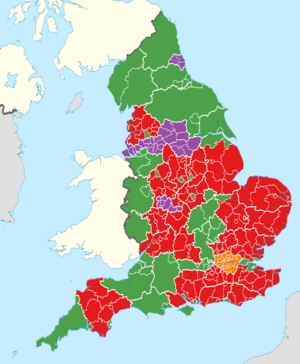Districts of England facts for kids
Quick facts for kids Local Authority District |
|
|---|---|
 |
|
| Category | Administrative district |
| Location | England |
| Found in | Counties |
| Created by | Local Government Act 1972 London Government Act 1963 |
| Created | mostly 1 April 1974 and 1 April 1965 some earlier (see text) |
| Number | 326 (as of 2005 est.) |
| Possible types | Metropolitan (36) Non-metropolitan (226) ∟ Two-tier (164) ∟ Unitary authority (62) London borough (32) sui generis (2) |
| Possible status | City Royal borough Borough |
| Populations | 2,300 – 1.1 million |
| Areas | 3 – 5,013 km2 (1 – 1,936 sq mi) |
The districts of England are special areas used for local government. Think of them as smaller parts of England, each with its own local council. These councils help manage things like schools, roads, and rubbish collection in their area.
There are currently 326 districts in England. They come in different types because local government isn't exactly the same everywhere. The main types are:
- Metropolitan boroughs
- London boroughs
- Two-tier non-metropolitan districts
- Unitary authorities
Some districts also have special titles like "city," "borough," or "royal borough." These are just honorary names and don't change what the district does or how its council works. Many districts are led by a mayor. Most mayors are ceremonial figures, but some are directly elected and make important decisions for their area.
Contents
How Districts Started in England
Before districts existed, local government in England was handled by parishes. These were small areas, often linked to a local church. They managed both church and everyday community matters.
Over time, these parishes were grouped together for different purposes, like helping the poor or keeping areas clean. In 1894, a new law created "urban districts" and "rural districts" as parts of larger areas called "administrative counties." This was a big step towards the system we have today. Later, in 1900, 28 "metropolitan boroughs" were created in London.
The current system of districts began in 1965 with the creation of Greater London and its 32 London boroughs. These are the oldest type of district still in use today. Then, in 1974, new "metropolitan counties" and "non-metropolitan counties" were set up across the rest of England. These were then divided into "metropolitan districts" and "non-metropolitan districts."
In 1986, the London boroughs and metropolitan districts became even more powerful. They took over many jobs from the larger county councils, which were closed down. Later, in the 1990s, a new type of district called a "unitary authority" was created. These combine the jobs of both county and district councils into one.
Understanding Metropolitan Boroughs
Metropolitan boroughs are a type of district found within metropolitan counties. These boroughs are similar to unitary authorities because the larger metropolitan county councils were abolished in 1986. This means metropolitan boroughs handle most local services themselves.
However, some services are still managed together by several boroughs. These districts are usually quite large, with populations ranging from about 174,000 to over 1 million people.
Exploring Non-Metropolitan Districts
Non-metropolitan districts are the most common type of district in England. They are part of a "two-tier" system, meaning they share power with a larger county council. These districts are found within shire counties.
In this two-tier system:
- County councils are in charge of big services like education, social services, and major roads.
- District councils handle other services, such as collecting rubbish, local planning, and managing council housing.
The number of these two-tier non-metropolitan districts has changed over the years. Many have become unitary authorities, reducing their total number to 164 by 2023.
What are Unitary Authorities?
Unitary authorities are a special type of non-metropolitan district. They are "single-tier" authorities, meaning they are responsible for all local services in their area. They combine the jobs that would normally be split between a county council and a district council.
These authorities were created in the mid-1990s. They often cover large towns and cities, as this system is seen as more efficient. Some smaller counties, like Rutland and the Isle of Wight, are also unitary authorities. There are currently 62 unitary authorities in England.
For example, Cornwall and Wiltshire are unitary authorities. This means their single council handles everything from schools to waste collection.
London Boroughs Explained
The 32 London boroughs are the local government areas that make up Greater London. They were first set up in 1965.
From 1965 to 1986, London had a two-tier government system, where the boroughs shared power with the Greater London Council (GLC). When the GLC was abolished in 1986, the London boroughs gained similar powers to unitary authorities, managing most services themselves.
In 2000, the Greater London Authority was created, bringing back a two-tier structure for London. However, the London boroughs still have a lot of power and responsibility. Each London borough council is in charge of many important services for its residents, including:
- Schools
- Waste management
- Planning applications
- Social services
- Libraries
Images for kids
See also
 In Spanish: Distritos de Inglaterra para niños
In Spanish: Distritos de Inglaterra para niños


